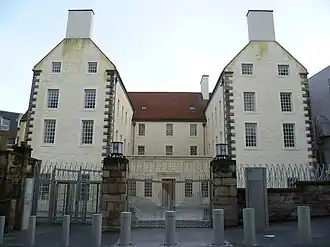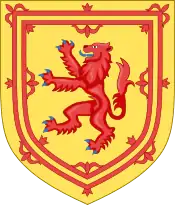Queensberry House
Queensberry House is a building of 17th-century origin which is now a Category A listed building. It stands on the south side of the Canongate, Edinburgh, Scotland, incorporated into the Scottish Parliament complex on its north-west corner. It contains the office of the Presiding Officer, two Deputy Presiding Officers, the Parliament's Chief Executive, and other staff.

| This article is part of a series on the |
| Politics of Scotland |
|---|
 |
|
|
History
The mansion house was built in 1681 for Charles Maitland, Lord Hatton[1][2] and then bought by William Douglas, 1st Duke of Queensberry in 1686.[3] He died in the house in 1695 and it then passed to his son, James Douglas, 2nd Duke of Queensberry, who was one of the Scottish peers signing the Treaty of Union in 1707.[4] The public reaction to his involvement in the treaty was harsh, as it was seen as treasonous and self-serving (he received titles and monies for his involvement), and his house was attacked by the Edinburgh mob.[5]
On his death in 1711 the house passed to his second son Charles Douglas who had been born in the house in 1698.[6] His wife, Catherine, Duchess of Queensberry, was the patroness of the poet John Gay who visited several times.[7]
From 1803 to 1996 the building was used as a hospital. This included a period during the cholera epidemic in the 1830s when it was specifically used as a cholera hospital.[8]
In the 1850s it was a House of Refuge and Night Asylum, i.e. a lodging house for homeless persons[9] and continued in this use until the Second World War. In 1945 it became a home for the elderly homeless on a more long-term basis for the individuals involved. It was acquired by the Scottish Government in 1997.[10] Up until this acquisition it was enclosed by its original 3m high stone garden walls, but it was decided these should be replaced by open railings.[11]
In popular culture
Ian Rankin's Inspector Rebus novel Set in Darkness, first published in 2000 is partly set in Queensberry House during the reconstruction for the new parliament building.[12]
Ghost
The building is said to be haunted by the kitchen boy roasted and eaten by James Douglas, the mad Earl of Drumlanrig, in 1707.[13][14]
References
- Cassell's Old and New Edinburgh
- Buildings of Scotland: Edinburgh by Gifford, McWilliam and Walker
- "Queensberry House | Edinburgh World Heritage". Edinburgh World Heritage. Retrieved 19 September 2018.
- Henderson, Thomas Finlayson (1888). . In Stephen, Leslie (ed.). Dictionary of National Biography. 15. London: Smith, Elder & Co. pp. 323–326.
- Cassell's Old and New Edinburgh vol. III p.36
- Cassell's Old and New Edinburgh vol III p.37
- "John Gay". Westminster Abbey. Retrieved 20 June 2019.
- Biographical Index of Former Fellows of the Royal Society of Edinburgh 1783–2002 (PDF). The Royal Society of Edinburgh. July 2006. p. 384. ISBN 0 902 198 84 X.
- 1854 Ordnance Survey map
- "Queensberry House". ewh.org.uk. Retrieved 19 June 2019.
- Edinburgh and District: Ward Lock Travel Guide 1930
- "First catch your spit-roasted servant". The Guardian. 12 March 2000. Retrieved 31 January 2019.
- "Why you've more than a ghost of a chance of seeing a spook". The Scotsman. 8 November 2004. Retrieved 5 March 2015.
- "Edinburgh-Royal Mile History The Canongate". Royalmile.com. Retrieved 21 November 2011.